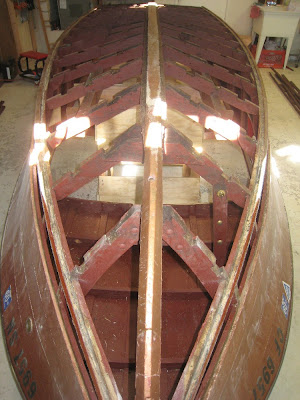With the bottom planks off, we are ready to get the boat setup and level. Using 2 floor jacks, first the rear, then the front dollies were jacked up and the sawhorses assembled.
Crawling under the covering boards, it was tight quarters to assemble the sawhorses.
Setup on the adjustable sawhorses, we removed the bottom plank battens and the topside chine planks. Then we began to level the chines port to starboard, first at the sawhorses and then each frame. Using a 6’ level with equal length spacer blocks, the wedges under the support of the sawhorse where adjusted.
Next, we added supports about the perimeter to support and adjust the twist in the framework. Cinder blocks, 2-2”x6” blocks, foam rubber and wedges are setup to lift frame stations into level.
Finally, the line projecting laser level was used to bring each frame station level port to starboard. The wedges between the 2”x6” blocks were adjusted to raise the low side at the major frame stations until each was level.





















